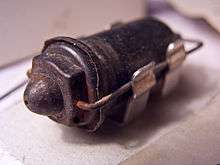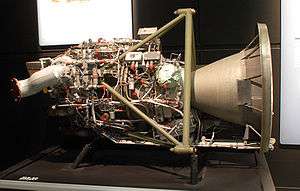Jetex
The Jetex motor is a type of solid-fuel rocket motor produced for use as a powerplant for model aircraft. Originally developed in 1947, by Wilmot, Mansour & Company Ltd of Southampton, it was first demonstrated to the modelling press in early 1948, and was available to the public in June 1948, when Aeromodeller featured Jetex power on its front cover. The first motors were the Jetex 100 and 200, with the more powerful Jetex 350 following in November 1948. The most popular motor, the Jetex 50, was introduced in May 1949, along with kits for a model plane and model car using Jetex power.


Jetex motors are powered by a solid pellet of guanidine nitrate, which burns to release a variety of gases in copious volume, leaving no solid residue or ash. Thrust developed is fairly modest, suitable for horizontally launched flying models rather than vertically launched rockets. The exhaust gas is not excessively hot, which confers a safety advantage. Fuel and wick to ignite the pellets was manufactured by Imperial Chemical Industries (ICI). The engine casing was made of an aluminium alloy and was reusable, new fuel pellets and ignition wick being a consumable that could be bought and used in the engine.
Jetex power made a big impact in the late forties and early fifties, allowing new sorts of models, scale and duration, to be designed. Its popularity waned after the mid-fifties, although the motors were used quite extensively by AP Films/Century 21, during the 1960s for producing model vehicle exhaust effects for the 'Supermarionation' TV series. By the late 1970s Jetex power had been largely forgotten. Recently, there has been a reawakening of interest in Jetex; in the mid-1990s, a similar device called the Rapier was launched, and many old plans for Jetex powered models were dusted off and built with the new motors.
Compared with modern Estes-type rockets, the Jetex is quite different. It has a much gentler, cooler exhaust, so flight characteristics tend to feature gradual acceleration rather than firework-like performance. The cooler exhaust is easier to handle and does not require extensive flameproofing of the airframe. However, the fuel is more toxic and requires special handling to keep it dry and in working condition (the fuel is slightly deliquescent and will gradually absorb moisture from the atmosphere which quickly renders it inactive). As a result, Jetex were quite unreliable, often failing to ignite.
External links
| Wikimedia Commons has media related to Jetex motors. |
- Jetex.org This non-profit site is "the premier Web resource for information and advice about models powered by micro rocket motors, especially those exemplified by the Jetex series of engines".
